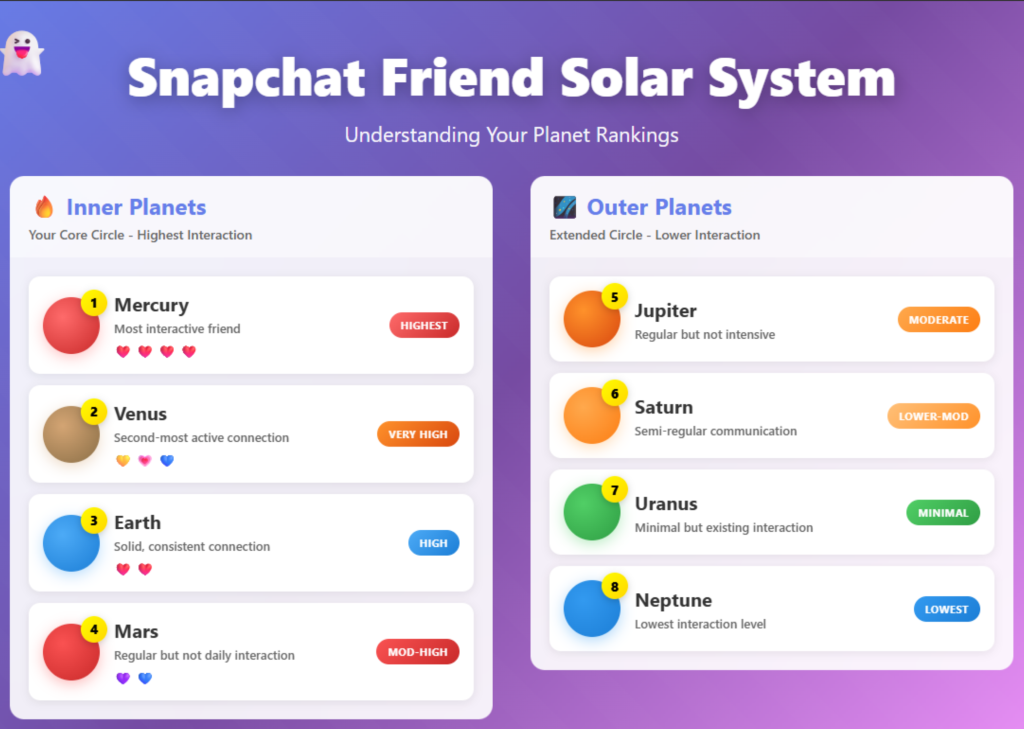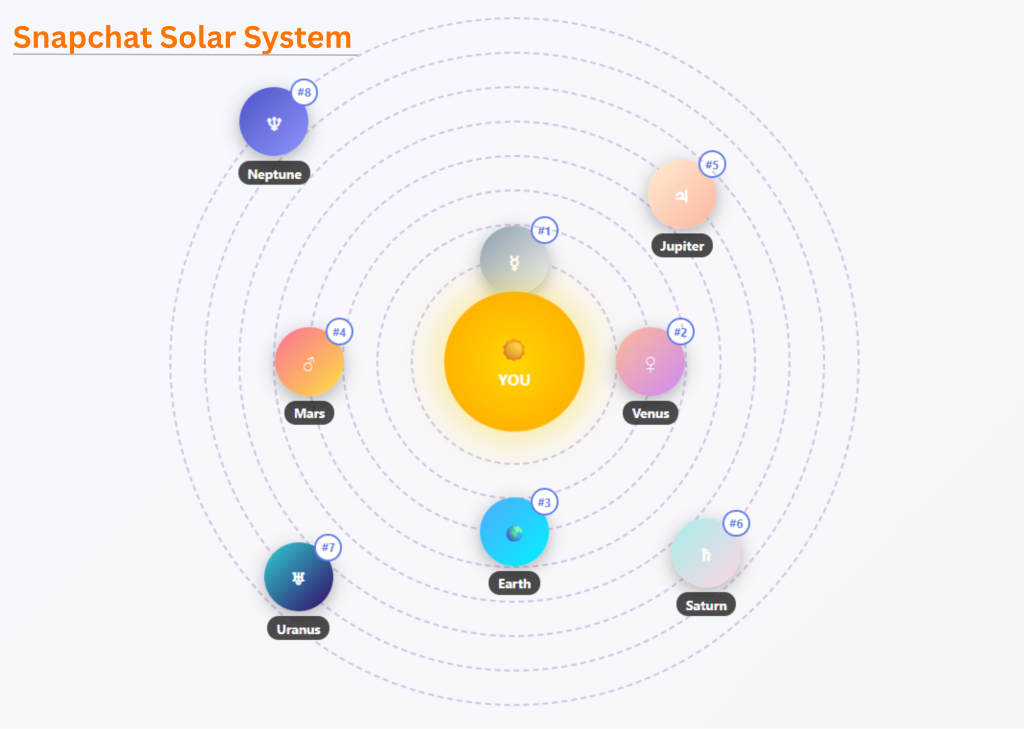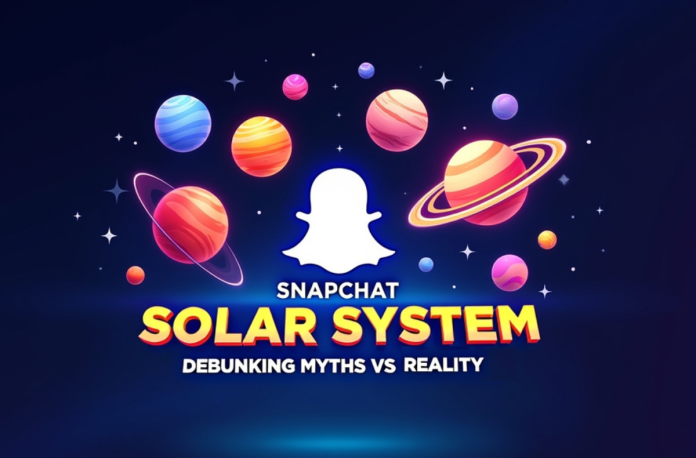Are you Mercury or Neptune in your best friend’s orbit? If you’re a Snapchat+ user, you’ve probably noticed the Snapchat Solar System feature that turns your friend list into a cosmic ranking. This has sparked a lot of curiosity, confusion, and even a little bit of drama. What does it actually mean to be someone’s Earth or Jupiter?
Many users believe their planet rank is a true reflection of their friendship’s quality, leading to some wild myths and misconceptions. The truth is much simpler. The truth is very simpler and to the point. This guide will debunk the common myths about the Snapchat Solar System, explain what your planet rank really means, and show you how to use this fun feature without overthinking it.
Table of Contents
- What is the Snapchat Solar System?
- Planet Ranks Explained: The Snapchat Solar System Order
- Common Myths and Misconceptions About the Snapchat Solar System
- How to Use and Manage the Snapchat Solar System
- The Psychology Behind Planet Rankings
- Real User Experiences: Planet Drama and Digital Dynamics
- Your Guide to a Healthier Cosmic View
- FAQs
What is the Snapchat Solar System?
The Snapchat Solar System is an exclusive feature available to subscribers of Snapchat+, the app’s premium service. It visualizes your top eight friends as planets revolving around you, who are positioned as the Sun. Think of it as a gamified version of your best friends’ list.
This feature, also known as the Friend Solar System Snapchat, ranks your friends based on your digital interaction frequency. The more you snap and chat with someone, the closer their planet will be to you (the Sun) in the solar system Snapchat. It’s a dynamic and private way to see who you’re connecting with the most on the platform. The best part? Your Snapchat Solar System is a purely private affair, so that your friend would not be aware of their position unless you tell them.
Planet Ranks Explained: The Snapchat Solar System Order
So, what do the planets in the solar system on Snapchat mean? The Snapchat Solar System order is easy: it determines your top eight friends by the level of your interactions. Your most-interacted-with friend of the most gets the spot next to the Sun (Mercury), and the eighth most-interacted-with friend is the last (Neptune).
Here is the complete solar system Snapchat order and what each planet signifies:
| Planet | Rank | Meaning in the Snapchat Solar System |
|---|---|---|
| Mercury | #1 | Your absolute closest friend based on snaps and chats. |
| Venus | #2 | Your second-best friend. You interact with them very frequently. |
| Earth | #3 | Your third-closest friend, a solid member of your inner circle. |
| Mars | #4 | A friend you chat with often, likely holding a Snapstreak with you. |
| Jupiter | #5 | A good friend you connect with, but less than your top four. |
| Saturn | #6 | Your sixth-best friend, with whom interactions are less frequent. |
| Uranus | #7 | You interact with this friend occasionally. |
| Neptune | #8 | Your eighth-best friend, on the outer edge of your frequent contacts. |
This Snapchat Solar System ranking is determined by an algorithm that analyzes the frequency of your interactions. The planet order is a direct representation of how often you’re sending snaps and messages to each other within the app.

Common Myths and Misconceptions About the Snapchat Solar System
The Snapchat Solar System has created a universe of myths. Here are a few most common misunderstandings about the planetary system.
Myth 1: Planet Rank Equals Friendship Quality
The Reality: The most common belief is that the Snapchat planet solar system is an exact measure of your friendship. It is absolutely not the case. The Snapchat Solar System’s meaning is purely based on the volume of digital interactions, snaps, and chats within the app. A high rank just means you talk a lot on Snapchat, not that you’re necessarily better friends.
Myth 2: Being Mercury Means You’re Their #1 Best Friend Forever
The Reality: Seeing yourself as Mercury in a friend’s solar system on Snapchat Plus can feel like a big deal, but these ranks are not permanent. The How does the Snapchat Solar System work question has a simple answer: it’s dynamic. If you stop interacting as frequently, that Mercury status can quickly change. The provided information relies on the recent activities of the users, usually those that are executed on the platform within seven days.
Myth 3: Disappearing from Someone’s Solar System Means Friendship Over
The Reality: If a friend of yours disappears from your friend’s solar system on Snapchat, you shouldn’t freak out! It doesn’t signal the end of your friendship. It simply means your interaction levels on the app have decreased, and they’ve fallen out of your top eight most-contacted friends. This is a system that is flexible enough to adapt to the changing ways of communication, connecting people rather than being a deathblow to an actual relationship.
Myth 4: The Ranking Is a Complete Assessment of Your Social Circle
The Reality: The Snapchat best friend solar system is just an ordering of your top eight closest friends. It doesn’t cover all the people you value. Friendships that exist primarily offline or on other platforms won’t be reflected in your Snapchat Solar System. It’s just one narrow, gamified view of your social life.
It is really helpful for people to understand the algorithm’s functioning correctly. In a sentiment analysis of online discussions to be conducted in 2025, it was found that 33% of the users are happy with the feature, 52% of them feel lost, and even 15% of the users are angry or have privacy issues.

How to Use and Manage the Snapchat Solar System
Ready to explore your own cosmic friend circle? First, you need to be a Snapchat+ subscriber. Once you’ve subscribed, you can enable the feature.
How to enable the Snapchat Solar System:
- Open the Snapchat app and tap your Profile icon (Bitmoji) in the top-left corner.
- Tap on the Snapchat+ banner under your name.
- Scroll down the list of features until you find “Friend Solar System.”
- Toggle the switch ON.
Once enabled, you can see where you stand in a friend’s orbit.
How to check your planet in a friend’s solar system:
- Go to a friend’s profile.
- Look for the “Best Friends” or “Friends” badge under their name. It will have a gold ring around it.
- Tap the badge. It will reveal which planet you are in their Snapchat Solar System, telling you your rank from #1 to #8.
What do the badges mean?
- Best Friends Badge: You are in each other’s top eight.
- Friends Badge: You are in their top eight, but they are not in yours.
You can toggle the Snapchat Solar System feature off at any time from the same Snapchat+ settings page if you decide you don’t want to see it.
The Psychology Behind Planet Rankings
It is required to go beyond the superficial gamification to know what the solar system stands for on Snapchat if you are understanding it correctly.
The gamification of friendship on Snapchat can be viewed as adding pressure to one’s being by constantly keeping the interaction level just at the bottom of the exclusive planetary positions. The social comparison might happen accidentally, the very moment the Snapchat planets come to play. Some users might feel the numb pain of being Neptune in someone’s set and that person being their Mercury simultaneously, which is distorting the relationship perception in a way.
Real User Experiences: Planet Drama and Digital Dynamics
“My roommate became Saturn in my solar system, and I was so lost,” said Sarah, a student at the University of California. We live together, talk every day, and yet she hardly has a Snapchat. Meanwhile, this dude from my chemistry class was Mercury just because we bitched about homework all the time.”
A key is shown here about how the solar system functions on Snapchat, and it follows digital behavior rather than real-world proximity or emotion.
Another Snapchat user, jaden530 on Reddit, said: “For me, it changed recently. It used to show the friend as the sun, and then I would be a planet showing where I was in their friend ranking. Now, on all of my friends, I am the sun, and they are the planets showing where they are on my friend list. Which I can literally already see by just looking at my best friends when I go to send a snap. Am I missing something?”
Your Guide to a Healthier Cosmic View
Snapchat Solar System is an interesting and humorous feature that was created to be an entertaining and fun part of the user’s digital friendship experience. In particular, this feature visualizes who the most interactive friends are in the app; it doesn’t interpret the relationships in any way.
The thing with the Solar System Snapchat is to love it as it is and not to allow it to be the judge of your real connections’ worth. Being Mercury or Neptune does not matter when it comes to the most important thing, which is being with your friends, other than through the device. Come on and have a look at your Snapchat solar system ranking, make fun of it, and then let’s build some real-life relationships with those people you like the most.
FAQs
The Snapchat solar system rankings update based on your recent activity, typically reflecting the past week’s interactions rather than lifetime totals.
No, you can only see your position in someone else’s solar system if they have Snapchat+ turned on and you are in their top 8.
Plant positions depend on the frequency of interaction. If you or your friend start snapping others more often, the slots will adjust themselves.
For viewing your own solar system and others’ places in it, one person needs to turn on the Snapchat+ feature, and you may or may not be that person. Moreover, to see your rating in someone else’s system, you also need Snapchat+.
Yes, the option to disable the Friend Solar System feature existed quietly under your Snapchat+ settings, and you were not required to buy any additional features separately.











